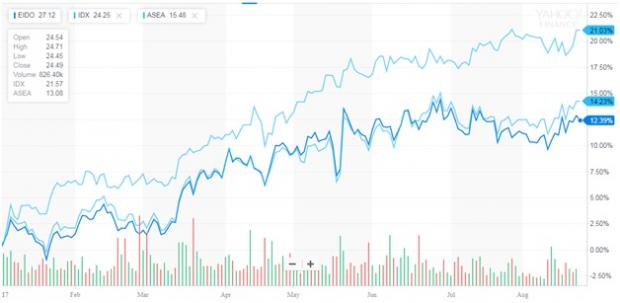Indonesia’s central bank unexpectedly cut its benchmark interest rate by 25 basis points on August 22, 2017. It now stands at 4.5%.
Improving inflation outlook and less hawkish stance of the U.S. Federal Reserve led to this decision. A mere six out of 28 economists surveyed by Bloomberg predicted a rate cut, while others expected the bank to hold.
The easing stance of central bank governor Agus Martowardojo reflects lesser concerns over the United States Federal Reserve monetary policy tightening leading to investment outflows from emerging markets. Owing to subdued inflation in the United States, the Fed is expected to adopt a gradual stance on further rate hikes.
Indonesia’s GDP grew 5% year over year in the second quarter of 2017, per Badan Pusat Statistik Indonesia. This was below Bloomberg’s estimate of 5.08% and same as the growth rate in the previous quarter. It grew 4% on a sequential basis compared with estimates of 4.07%.
The growth rate is still far from president Joko Widodo’s target of a 7% growth rate during his term, which is supposed to end in 2019. However, his government expects a mere 5.2% growth rate for 2017, which a few analysts say is inadequate.
Consumer prices in Southeast Asia’s largest economy grew 3.88% in July compared with a 4.37% in June. Bank Indonesia targets an annual headline inflation rate in the range of 3-5% for 2017. Inflation is expected to be in the middle of the central bank’s target range (read: Indonesia's Inflation Eases: ETFs in Focus).
Despite six rate cuts last year, the economic growth has not been that impressive. Therefore, after the most recent rate cut, economists expect further rate cuts this year in order to live up to the economic growth expectations.
In the current scenario, let us discuss a few ETFs focused on providing exposure to Indonesian equities (see all Broad Emerging Market ETFs here).
iShares MSCI Indonesia ETF EIDO
This fund is appropriate for investors looking to gain exposure to companies based in Indonesia. Thus, it offers a pure play on Indonesia.
It has AUM of $507.86 million and charges a fee of 63 basis points a year. From a sector look, Financials, Telecommunication Services and Consumer Discretionary are the top three allocations of the fund, with 32.75%, 15.30% and 13.85% exposure, respectively (as of August 21, 2017). From an individual holdings perspective, Telekomunikasi Indonesia, Bank Central Asia and Bank Rakyat Indonesia (Persero) are the top three holdings of the fund, with 13.60%, 10.49% and 9.59% allocation, respectively (as of August 21, 2017). The fund has returned 12.39% year to date and 3.71% in the last one year (as of August 22, 2017). EIDO currently has a Zacks ETF Rank #2 (Buy) with a High risk outlook.
VanEck Vectors Indonesia Index ETF (AX:IDX)
This fund seeks to provide a bet on Indonesia by investing in companies based out of the nation or the ones who have a great deal of business interest there.
It has AUM of $67.7 million and charges a fee of 58 basis points a year. From a sector look, Financials, Consumer Staples and Consumer Discretionary, are the top three allocations of the fund, with 28.3%, 17.7% and 13.1% exposure, respectively (as of July 31, 2017). From an individual holdings perspective, Telekomunikasi Indonesia, Bank Central Asia and Bank Rakyat Indonesia (Persero) are the top three holdings of the fund, with 8.68%, 8.26% and 6.53% allocation, respectively (as of August 22, 2017). The fund has returned 14.23% year to date and 3.81% in the last one year (as of August 22, 2017). IDX currently has a Zacks Rank #2 with a High risk outlook.
Let us now compare the performance of the two funds to a broad Southeast Asia based ETF, ASEA.
Global X Southeast Asia ETF ASEA
This fund provides broad exposure to the five members of the Association of Southeast Asian Nations, Singapore, Indonesia, Malaysia, Thailand, and the Philippines. It is appropriate for those looking for a diversified exposure to South East Asia (read: Singapore GDP Growth Surpasses Estimates: ETFs in Focus).
ASEA is less popular with AUM of $13.80 million and charges a fee of 65 basis points a year. From a geographical perspective, the fund has 30.45% exposure to Singapore, 22.29% to Malaysia, 21.15% to Thailand, 19.67% to Indonesia and 6.44% to Philippines (as of June 30, 2017). Financials, Telecommunication Services and Industrials are the top three sectors of the fund, with 45.92%, 14.94% and 8.12% allocation, respectively (as of June 30, 2017). DBS Group Holdings Ltd, Oversea-Chinese Banking Ltd and United Overseas Bank Ltd are the top three holdings of the fund, with 7.21%, 7.11% and 5.84% allocation, respectively (as of August 22, 2017). The fund has returned 9.32% in the last one year and 21.03% year to date (as of August 22, 2017). ASEA currently has a Zacks Rank #3 (Hold) with a Medium risk outlook.
Below is a chart comparing the year-to-date performance of the three funds.

Source: Yahoo (NASDAQ:AABA) Finance
Want key ETF info delivered straight to your inbox?
Zacks’ free Fund Newsletter will brief you on top news and analysis, as well as top-performing ETFs, each week. Get it free >>
ISHARS-MS INDON (EIDO): ETF Research Reports
VANECK-INDONES (IDX): ETF Research Reports
GLBL-X SE ASIA (ASEA): ETF Research Reports
Original post
Zacks Investment Research
